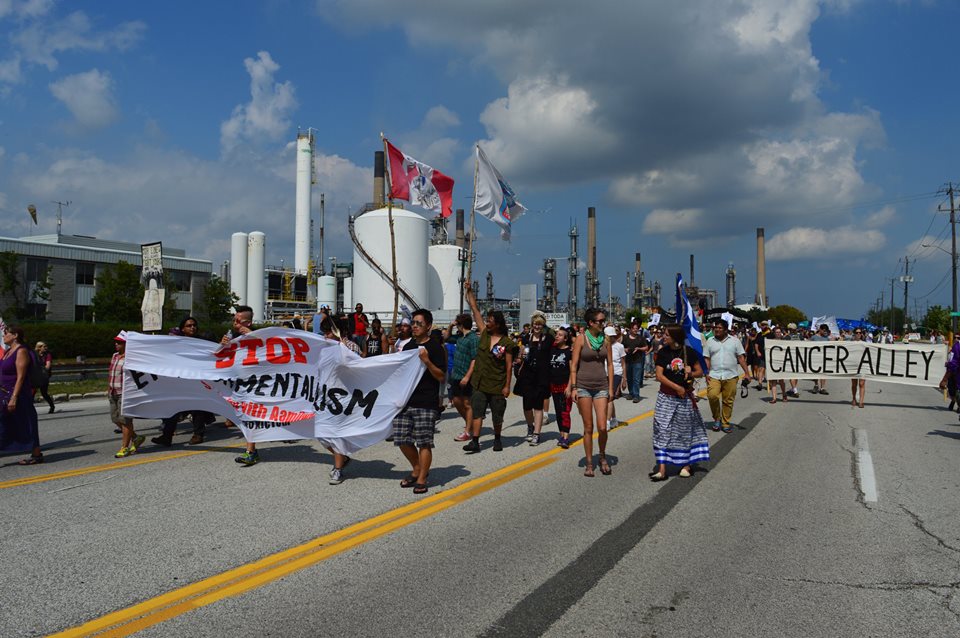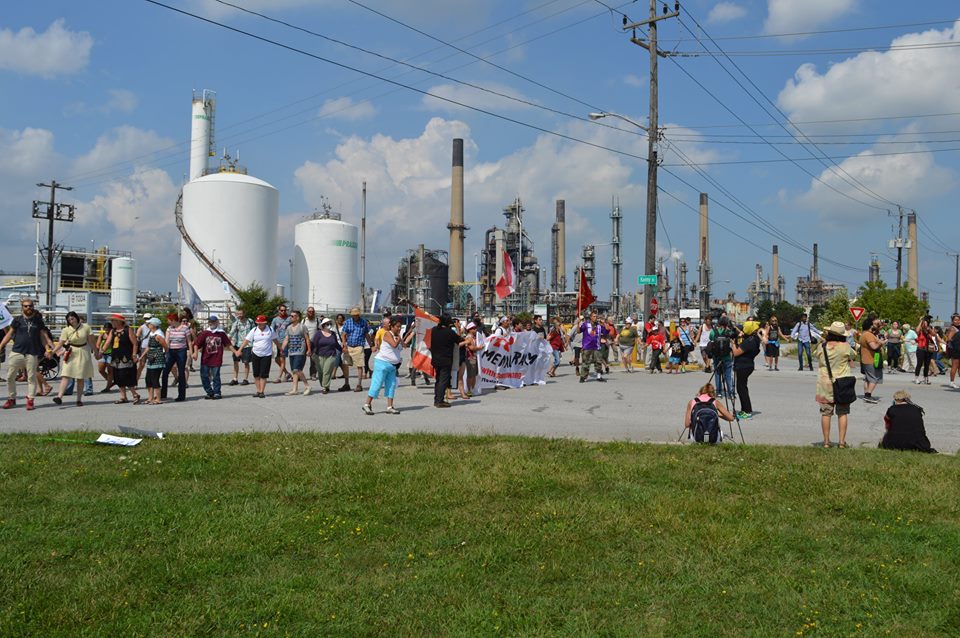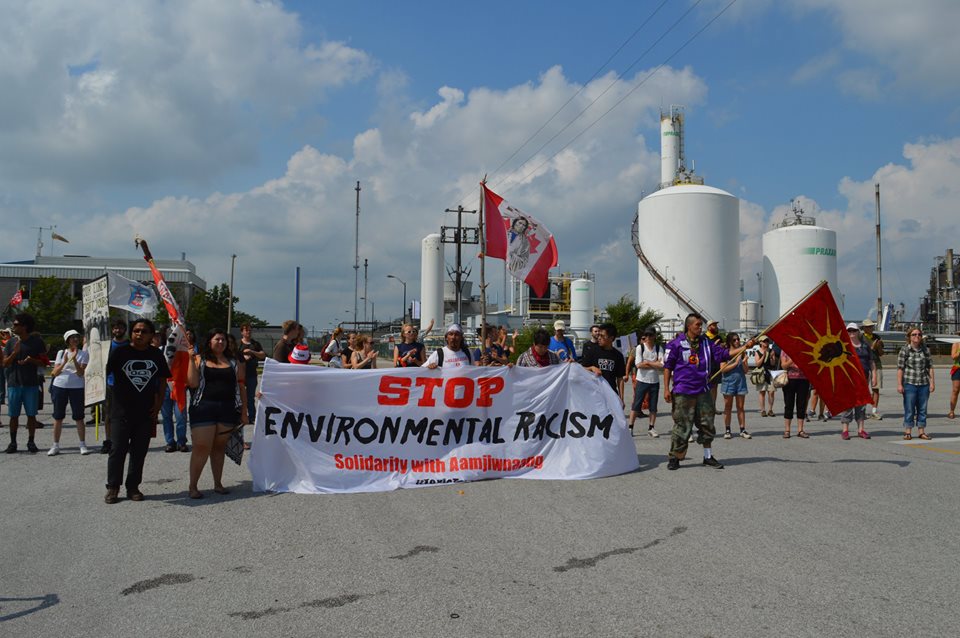Like this article? rabble is reader-supported journalism. Chip in to keep stories like these coming.
On Saturday Sept. 5 the Toxic Tour of the Chemical Valley had its biggest turnout to date, with well over 300 people seeing first-hand the industrial landscape of Chemical Valley.
The event has grown considerably since starting in 2013, the result of continuous efforts by Indigenous community members and responsive settler activist groups, like Rising Tide Toronto and the Guelph Anti-Pipeline Action Group.
On Friday Sept 4., 150 people packed into the Aamjiwnaang community centre for dinner, talks, poetry and music, predominantly from local Indigenous peoples, then outside for a campfire and camping in tents on the lawn. Rapper Lee Reed came from Hamilton, Test Their Logic from Toronto, and Metis poet Awasis from nearby London.
Leadership and solidarity
Sisters Lindsay and Vanessa Gray are leading forces in the Aamjiwnaang community and in the group Aamjiwnaang and Sarnia Against Pipelines (ASAP), which put on the Toxic Tour.
Vanessa Gray says of the relationship between Indigenous and settler organizers in putting the event together, “It’s been good for the different sorts of resources we’ve been able to use to make things like this possible. From different communities giving free printing, to performers coming in that are from the city and popular there.”
On Friday night nearly everyone helped make dinner, hundreds of bag lunches for the next day, and clean up, all in a do-it-yourself grassroots organizing style. The hosts in Aamjiwnaang provided land to gather and sleep on, water to drink, and knowledge the guests craved.
“A lot of what today was, was allyship coming in and supporting and doing what they can in their own communities and with their own organizing skills,” remarks Vanessa Gray. She cites the different protocols for Indigenous people and settler allies, “[Settlers] are just here for when we have need for them, and that’s what has been pushing us so far in this process of decolonization.”
Similar but different relationships of solidarity exist with other First Nations and settler communities, like with Grassy Narrows, Kanehsatake, Elsipogtog, and Unist’ot’en, to name a few.

Photo: Lana Goldberg
What is the Chemical Valley?
The area surrounding Aamjiwnaang First Nation is home to over 60 large chemical processing facilities, including Shell, Suncor, Imperial (Esso) and Enbridge, collectively making up 40 per cent of Canda’s petro-chemicals industry. The controversial Line 9 pipeline also has its western terminal there and hopes to soon pump bitumen east to Montreal.
Chemical Valley is often referred to as the most polluted place in North America, releasing chemicals like benzene, hydrogen sulfide, endocrine disruptors and heavy metals into the air and water.
In Aamjiwnaang, there is a 39 per cent rate of miscarriage and an abnormal 2:1 female-male birth rate. Cancers and cardiovascular disease are common in the community, often taking lives at young ages.
Chemical Valley was subject to some media attention for its health effects on chemical workers and residents of neighbouring Sarnia. But Aamjiwnaang, population 932 was ignored by media until Idle No More and residents who blockaded a rail line for days in December 2012.
In early 2015, one of Shell’s refineries spilled toxic water containing mercaptan, hydrogen sulfide, and benzene affecting a nearby daycare. The daycare nor the hospital were informed of the spill urgently, resulting in the children being misdiagnosed with the flu.
Later, Shell admitted to the spill and were charged under the Environmental Protection Act with causing adverse effects. “Children’s lives are never going to be the same because of these companies that are right across the road from us,” said Vanessa Gray.
Working through contradiction
The fact that most people got to the Chemical Valley in cars using refined oil and communicate with high-tech devices was not lost on Aamjiwnaang elder Lynn Rosales. Rosales pointed out how many things in our lives are produced in the Chemical Valley (and similar locations), including the microphone and speakers she was talking through to clothes we wear and cars we drive.
Rosales related this reality to two stories familiar in Anishanaabe culture: the 7th and 8th fires, and the serpent prophecy. These are not stories for a settler journalist to tell. However, what Rosales got across was that there are big choices we face in which direction humanity is headed. And these changes are neither small nor easy. They are fundamental, and deeply connected to the ever-growing petro-industry monster we are all part of.
It is the work of movements, including environmental and labour movements around the world, to bring about this transition and ensure people can lives with dignity.
Efforts are growing in Canada, from within Indigenous communities living off the land, like at the Unist’ot’en camp, and in collaborative manifestos like the Elan Global in Quebec and the forthcoming Leap Manifesto spearheaded by the This Changes Everything team.

Photo: Lana Goldberg
Moving forward
Asked about next steps, Vanessa Gray says, “We need to look more specifically at what we want done. And that would be to hold off a new bitumen refinery that is being proposed.” This proposed facility would refine inputs from the Alberta tar sands.
Several community members are currently engaged in a lawsuit arguing that the Ministry of Environment should consider health effects of processing facilities in terms of their cumulative emissions levels, not just individual emissions. The charity EcoJustice is helping represent them.
“We are also still going with the [Enbridge] Line 9 campaign. We would like that delayed as much as possible,” says Gray.
Several community members, noting the strong turn-out at the Toxic Tour, expressed hope for bigger numbers in the future, some half-joking that they wanted to see 10,000 people there.
“We would like to do more workshops and knowledge-building here on the reserve. There could be more organizers such as myself to pull events like this together. And it’s all about delegation and coordination and that’s something that can be learned and practiced. So we’d just like to go bigger next time,” said Vanessa Gray.
“What is really inspiring me and pushing me to do this today is the Unist’ot’en camp that is protecting the clean water,” says Gray of the land-defence camp in B.C. that is on high alert fearing an RCMP raid. “I had some from the river and it was such an unreal experience to be able to drink water from a river.”
The bottom of the St Clair River in Aamjiwnaang has a giant blob of toxic sludge, and there are plans to start fracking in the area.
“Coming back here it just pushes me to work harder. So my heart and my thoughts are with those who are [there] protecting that space.”
On Sunday, the Unist’ot’en camp shared a photo on social media showing they stand in solidarity with Aamjiwnaang.
David Gray-Donald studied Environment & Biology at McGill University then worked there facilitating community sustainability projects. He is trying to undo our reliance on fossil fuels and educate himself on how to be a responsible white guy. He lives in Montreal and Toronto.
Photos: Lana Goldberg



